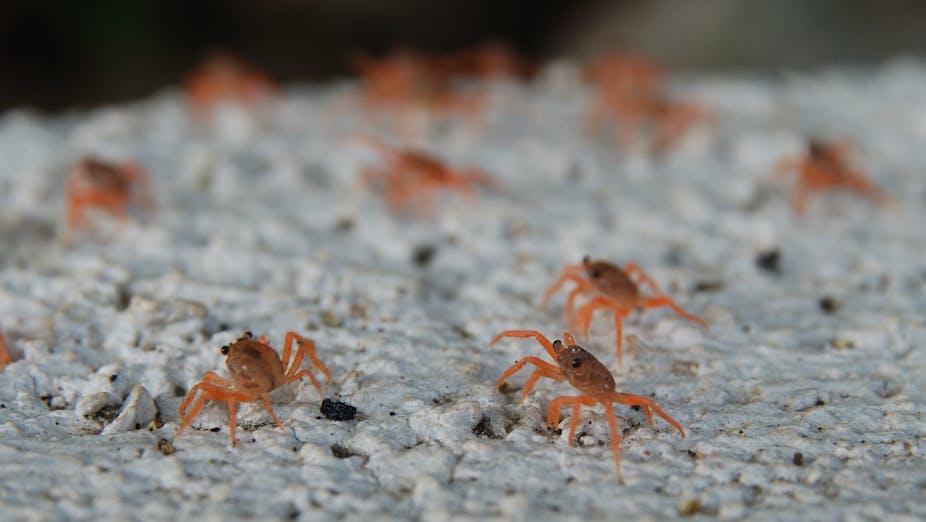Christmas Island has been once again in the headlines: not because of incidents involving asylum-seekers, but because of the recent sinking and breaking up of the Panamanian phosphate carrier MC Tycoon. This accident highlights Australia’s poor record in protecting its rich marine environment from shipping disasters.
Christmas Island deserves a prominent place in the news. It has unique biodiversity and has often been described as the Galapagos of the Indian Ocean. This uniqueness extends into the marine environment, where Australia’s most pristine coral reefs teem with an amazing array of animals.
The greatest wildlife spectacle on Earth
The marine life includes an eclectic mix of Indian and Pacific Ocean species as well as species found nowhere else on Earth. The island also holds the title for having the most number of hybrid reef fishes in the world. These attract considerable attention with their unique color patterns.
During the summer months the island comes alive. The onset of the wet season signals the annual spawning. This includes millions of red crabs whose spawning migration has been described by Sir David Attenborough as one of the greatest wildlife spectacles on Earth.
Whale sharks’ summer migration to Christmas Island is timed to coincide with this seasonal feast. The billions of eggs released into the sea by the crabs are gorged upon by the sharks – the largest fish in the sea.
The island is also internationally known for its importance as a seabird breeding ground, supporting numerous species including endemic and endangered species.
This unique combination of marine life is found nowhere else in the world. Christmas Island is one of the jewels in the crown of Australian’s natural heritage.
A deadly cocktail of pollution
When the MV Tycoon crashed, it spilled tonnes of oil, diesel and phosphate onto the pristine coral reefs. The mass release of pollutants is always untimely, but this incident is particularly so. It happened at Flying Fish Cove, the most ecologically valuable marine habitat on Christmas Island. Flying Fish Cove supports a unique community of coral and fishes found nowhere else around the island. The disaster could not have happened at a worse place, or time.

This is the critical time for the homeward migration of millions of baby red crabs, which are now struggling to swim through diesel, oil and phosphate. This is also the spawning season for the majority of the island’s marine species. The eggs and larvae of marine organisms are extremely vulnerable to pollutants such as fuels and oils. Furthermore, these larvae usually inhabit the surface layers, where these pollutants accumulate.
The combination of phosphate, oil and diesel is likely to be deadly. Phosphate often limits microbial activity, whereas oil and diesel provide a substrate for microbial growth. Rapid microbial growth may help decompose the oil and diesel, but is also likely to deplete oxygen. If there is a lack of water circulation, this will trigger a mass mortality event in this valuable ecosystem and possibly give rise to microbes producing toxins, such as dinoflagelates, which thrive under such conditions.
The island is poorly equipped to deal with such disasters, which limits the ability to minimise the impact. The environment will pay the price for our poor planning.
A pattern of poor planning
The Tycoon’s grounding is not an isolated incident. In October 2011, the MV Rena grounded off the coast of the North Island of New Zealand. We can only share the sense of helplessness felt by our New Zealand neighbours, watching the ship break up over months, powerless to alter its fate.

This is a much too familiar feeling for Australians, who, over the past couple of years, have witnessed the Pacific Adventurer leak 270,000 litres of fuel into Moreton Bay in March 2009, shortly followed by the uncontrolled discharge of oil and gas for over two months from the Montara platform, and then the Chinese-registered Shen Neng 1 ramming into Douglas Shoals in the Great Barrier Reef.
The Australian public has also been reading about the possible role of pollution in the deaths and disease of fish around Gladstone harbour. If we do not change our management practices than these maritime disasters will continue to devastate our unique marine life as shipping increases with Australia’s resource boom.
We cannot afford to continue to watch, helplessly, as these incidents take their (often irreversible) toll on our unique marine natural heritage. Resources delivered from, or transported through, the marine environment are at the heart of Australia’s economy, but the protection of our natural heritage is not only our responsibility, but is tightly linked to our own future as a nation.
A safe, sustainable future for our maritime economy
These two goals – delivering wealth from our oceans and conserving our marine natural heritage – are not irreconcilable. But to be reconciled, the delivery of wealth from our oceans must develop in a safe and sustainable way. It must be underpinned by scientific knowledge, infrastructure and resources so we can plan to minimise impacts from such accidents. We also need to be able to deliver timely and effective responses when these accidents do occur.

Australia, with a vast territory in the sea, is grossly under-resourced to provide the scientific knowledge needed to run these industries in a safe and sustainable manner. The challenge is not only to provide additional resources, but to embrace a paradigm shift. We must view the protection and stewardship of our natural resources as a priority in our defense policy.
The time for reactive responses is over, we must now move into a proactive approach to ensure safe and sustainable maritime operations in the Australian marine environment. Australians must be as proud of the nation’s approach to disaster prevention and management as we are of our wonderful natural heritage.
With thanks to Justin Gilligan at www.justingilligan.com for use of his photos.

